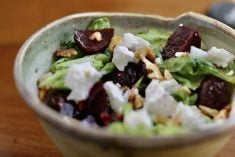I have been starting my mornings recently by enjoying the frost on the plum tree just outside my kitchen window.
The outside light shines on the frosty branches to give a sparkling effect in the pre-dawn light. It is so beautiful and starts my day with a sense of gratitude for such beauty in our world. The tree has only ever produced a half dozen plums in its lifetime but it fills my kitchen bay window with such seasonal beauty, it earns its keep.
Some mornings, my breath has almost been taken away by the beauty when I walk into the kitchen. In the spring I’m blessed with a tree full of pale pink blooms. During the summer there are dancing green leaves and birds that use it as their perch. For a few brief days in the fall I am greeted with brilliant gold and yellow colours. This is one of the pleasures of living in a part of the world where there are distinct seasonal changes.
Read Also

Communication key to bridging generation gap
Each generation is shaped by the predominant forces at play during their formative years. Acknowledging these influences can improve communication among the generations.
Muffin making
Muffins are a commonly purchased convenience food, but they are also quick and easy to make. Depending on the ingredients, they can also be an easy way to provide extra nourishment. Generally, they contain less sugar and fat than cookies and can be eaten with a meal, as a breakfast or as a snack.
There are basically two ways to make muffins: the muffin method and the creaming or cake method. The difference between the two is how the ingredients are combined and the resulting texture of the muffin.
The muffin method gives a
course bread-like texture while the creaming method produces a smaller, finer crumb with a more cake-like texture.
Muffin method
Two bowls are used in the muffin method. The dry ingredients are mixed together in one bowl, such as flour, baking powder, baking soda, salt, sugar, grains, nuts and fruit.
The wet or liquid ingredients go in the other bowl, such as eggs, milk, water, honey, oil, melted butter, extracts, yogurt, applesauce and purees.
This method requires that the shortening be in a liquid form. Use vegetable oil or melt the butter so it can be added to the liquid.
A hole is made in the middle of the dry ingredients and the wet mixture is added. The two are stirred together with a spatula or wooden spoon only until combined. Small lumps are OK because they will disappear during baking.
There is no need for an electric mixer because this will over mix the muffins. Over mixing will cause the gluten protein in the flour to develop, which will make the muffins tough, crumbly and tunnelled.
Preheat the oven so it will be ready to bake as soon as your muffin pans are filled. The longer the mixed batter sits, the less leavening power
it will contain, leading to dense muffins.
Savoury corn muffins
These light savory corn muffins are perfect brunch partners. They taste great with almost any main dish. Serve them warm with butter.
1 cup all purpose 250 mL
flour
1 cup cornmeal 250 mL
3 tablespoons 45 mL
granulated sugar
2 teaspoons baking 10 mL
powder
1/2 teaspoon salt 2 mL
1/2 teaspoon dried basil 2 mL
leaves
1 egg
1 cup milk 250 mL
1/4 cup melted 60 mL
vegetable shortening or
canola oil
1 cup cooked corn 250 mL
kernels
1/3 cup chopped black 75 mL
olives
1/4 cup chopped sun- 60 mL
dried tomatoes
Preheat oven to 400 F (200 C). Grease muffin cups or line them with muffin papers. Makes 10 large or 12 medium muffins.
Steps in the muffin method
Whisk the dry ingredients, flour, cornmeal, sugar, baking powder, salt and basil leaves together in a large bowl to make sure that the baking powder and other ingredients are well combined. Set aside.
Whisk the egg in a separate bowl with a French whip or fork. Add the other liquids, milk and melted shortening or oil and whisk again.
Add the corn, olives and tomatoes to the dry ingredients and mix to coat the vegetables with flour. This will ensure that they are evenly disbursed throughout the muffin instead of sinking to the bottom.
Make a well in the centre of the dry ingredients. Add the liquid all at once. Stir with a spatula until mixed well and moistened: some lumps will remain.
Spoon into greased muffin cups, filling about three quarters full.
Bake in the centre of a preheated oven for 15 to 20 minutes or until toothpick inserted in centre comes out clean. When muffins are put into the oven, turn the oven temperature down to 350 F (180 C).
Time saving tip: One advantage of the muffin method is that both the dry and the wet ingredients can be mixed the night before. Store the wet ingredients in the refrigerator and then add them to the dry ingredients in the morning or just before supper for fresh hot muffins.
Creaming or cake method
This method requires an electric mixer and uses solid butter or shortening. Place the butter or shortening in a mixing bowl. Add the sugar, spices and extracts. Cream the mixture together with an electric mixer until light. Then add the other ingredients. Recipes that call for oil instead of butter or shortening cannot be creamed unless you substitute with butter or solid shortening. The objective is to drive the sharp sugar crystals through the fat, creating tiny voids of air in the mixture. This air will help the muffins rise.
The creaming method has two advantages: the sugar and fat are well-dispersed in the batter and the air that is whipped into the mixture tends to make for a light, fine crumbed muffins.
Peachy poppy seed muffins
2/3 cup butter or 150 mL
shortening, softened
1 cup granulated 250 mL
sugar
2 eggs
1/2 teaspoon vanilla 2 mL
3/4 cup peach 175 mL
baby food
11/4 cups all purpose 310 mL
flour
1 teaspoon baking soda 5 mL
1/4 teaspoon salt 1 mL
2 tablespoons poppy 30 mL
seeds
Preheat oven to 350 F (180 C).
Steps in the creaming method
Using an electric mixer, cream together the butter or shortening and sugar until light.
Add the eggs one at a time, creaming after each. Stir in the vanilla and peach puree. Do not over stir because this can reduce the amount of air trapped in the creamed mixture.
Combine the flour, baking soda, salt and poppy seeds and add them to the creamed mixture. Mix just until combined.
Spoon batter into greased muffin cups, filling two-thirds full.
Bake at 350 F (180 C) for 20 to 25 minutes or until the tops spring back when lightly touched. Cool 10 minutes. Transfer to racks and cool completely.
- Try other fruit such as apricot and apple.
- If you are using whole or cut up fruit in your muffins, fold them in gently at the end of your mixing with a minimum number of folds. Fruit crushes easily in the thick batter and the juice will stain the batter.
How to bake muffins
Grease the muffin tins. The spray oils from an aerosol or self-pump container make it easier to reach the corners of the tins. Be sure to cover the top edges where the muffins will flow when baking.
Paper liners can be used but since the batter adheres slightly to the paper, the muffins will have slightly less volume. Removing the paper from the muffin can be messy and there’s more garbage to deal with.
Temperature is one of the secrets to nicely domed muffins. Commercial ovens use precise heat settings and timers. There are several ways to achieve these results at home:
- Make sure that the oven is completely heated before baking. Let the oven sit at full temperature for at least 10 minutes before baking so that the heat is well absorbed into the structure of the oven.
- When putting the muffins in the oven, close the door as quickly as possible to keep the heat trapped.
- Set the temperature at a higher initial setting. The higher heat creates a burst of steam that lifts the batter. Lower the temperature when muffins are placed in the oven.
- Place the muffins in the upper third of the oven where it tends to be hotter and more constant.
Use an ice cream scoop with wire release to put batter into muffin pans. This results in a uniform size and nicely shaped top. Make sure that the muffin tins are evenly filled so that they bake evenly. Most recipes direct that the muffin tins be filled two-thirds to allow room for expansion.
Bake muffins until they are a light golden brown. The top should spring back when gently pressed and a toothpick inserted in the centre should come out clean. Over-baked muffins will be dry and tough. Under-baked muffins may be heavy.
It is easy to tear apart hot muffins when trying to lift them from the tins. Instead, let the muffins sit for a few minutes and they should easily lift out intact. Place them on wire racks to continue cooling.
Muffins are best served hot and do not keep well beyond the first day. Freeze extras to reheat later. To reheat, wrap in foil and bake about 10 minutes at 350 F (180 C) or heat in a microwave oven at 50 percent power until they are warm. This takes one to two minutes depending on the number of muffins being heated.
Sources: www.preparedpantry.com and www.robinhood.ca.
Betty Ann Deobald is a home economist from Rosetown, Sask., and one of four columnists comprising Team Resources. Send correspondence in care of this newspaper, Box 2500, Saskatoon, Sask., S7K 2C4 or contact them at team@producer.com.














